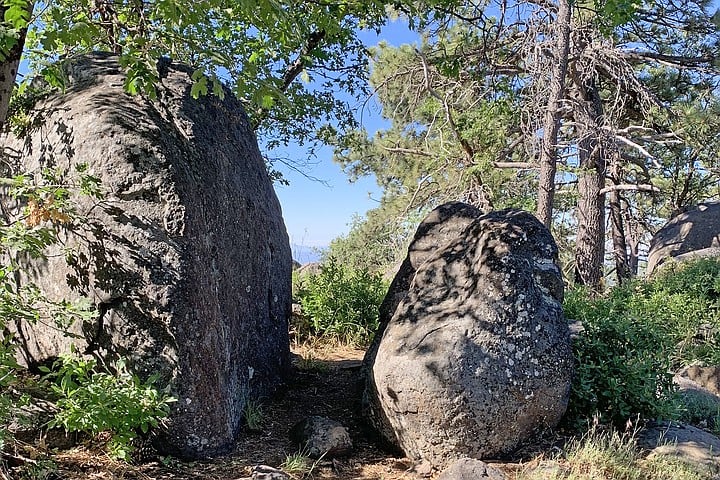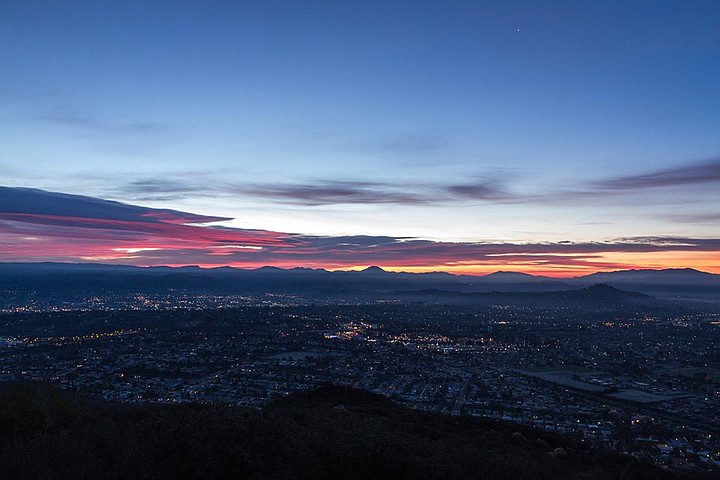 Facebook
Facebook
 X
X
 Instagram
Instagram
 TikTok
TikTok
 Youtube
Youtube

Winter Solstice, the moment when the sun reaches its southernmost point on the celestial sphere, occurs this year at 2:02 a.m., Monday, December 21. This event signals the beginning of winter in the Northern Hemisphere and the beginning of summer in the Southern Hemisphere. With only about ten hours of daylight, San Diego must endure its darkest and gloomiest nights this week and next. During the day, the sun struggles to an altitude of only 34 degrees (as seen from San Diego), then quickly sinks toward the horizon.

Hike to San Diego County’s High Places to take advantage of the winter season’s characteristically clear air. From spots such as Cuyamaca Peak in Cuyamaca Rancho State Park, Wooded Hill in the Laguna Mountain Recreation Area, and Boucher Hill at Palomar Mountain State Park, vistas stretching a hundred miles across the Pacific Ocean are not uncommon at this time of year. Look for the dark profiles of Santa Catalina and San Clemente islands, lying northwest and west of San Diego respectively.

Spectacular Sunsets and Sunrises are characteristic of winter’s dry spells. You can drive up to Soledad Park in La Jolla or Mount Helix near La Mesa for an all encompassing view. Or try hiking up to vantage points such as Cowles Mountain in the San Carlos area and Woodson Mountain near Ramona. Don’t forget to bring a flashlight for the trip up or down.
Sirius and Procyon in the balance. Sirius, the Dog Star, sparkles low in the east-southeast after dinnertime. Procyon, the Little Dog Star, shines in the east about two fist-widths at arm's length to Sirius's left.
But directly left? That depends. If you live around latitude 30° (Tijuana, New Orleans, Jacksonville), the two canine stars will be at the same height above your horizon soon after they rise. If you're north of that latitude, Procyon will be higher. If you're south of there, Sirius will be the higher one. Your eastern horizon tilts differently with respect to the stars depending on your latitude.
The above comes from the Outdoors listings in the Reader compiled by Jerry Schad, author of Afoot & Afield in San Diego County. Schad died in 2011. Planet information from SkyandTelescope.org.


Winter Solstice, the moment when the sun reaches its southernmost point on the celestial sphere, occurs this year at 2:02 a.m., Monday, December 21. This event signals the beginning of winter in the Northern Hemisphere and the beginning of summer in the Southern Hemisphere. With only about ten hours of daylight, San Diego must endure its darkest and gloomiest nights this week and next. During the day, the sun struggles to an altitude of only 34 degrees (as seen from San Diego), then quickly sinks toward the horizon.

Hike to San Diego County’s High Places to take advantage of the winter season’s characteristically clear air. From spots such as Cuyamaca Peak in Cuyamaca Rancho State Park, Wooded Hill in the Laguna Mountain Recreation Area, and Boucher Hill at Palomar Mountain State Park, vistas stretching a hundred miles across the Pacific Ocean are not uncommon at this time of year. Look for the dark profiles of Santa Catalina and San Clemente islands, lying northwest and west of San Diego respectively.

Spectacular Sunsets and Sunrises are characteristic of winter’s dry spells. You can drive up to Soledad Park in La Jolla or Mount Helix near La Mesa for an all encompassing view. Or try hiking up to vantage points such as Cowles Mountain in the San Carlos area and Woodson Mountain near Ramona. Don’t forget to bring a flashlight for the trip up or down.
Sirius and Procyon in the balance. Sirius, the Dog Star, sparkles low in the east-southeast after dinnertime. Procyon, the Little Dog Star, shines in the east about two fist-widths at arm's length to Sirius's left.
But directly left? That depends. If you live around latitude 30° (Tijuana, New Orleans, Jacksonville), the two canine stars will be at the same height above your horizon soon after they rise. If you're north of that latitude, Procyon will be higher. If you're south of there, Sirius will be the higher one. Your eastern horizon tilts differently with respect to the stars depending on your latitude.
The above comes from the Outdoors listings in the Reader compiled by Jerry Schad, author of Afoot & Afield in San Diego County. Schad died in 2011. Planet information from SkyandTelescope.org.
Comments